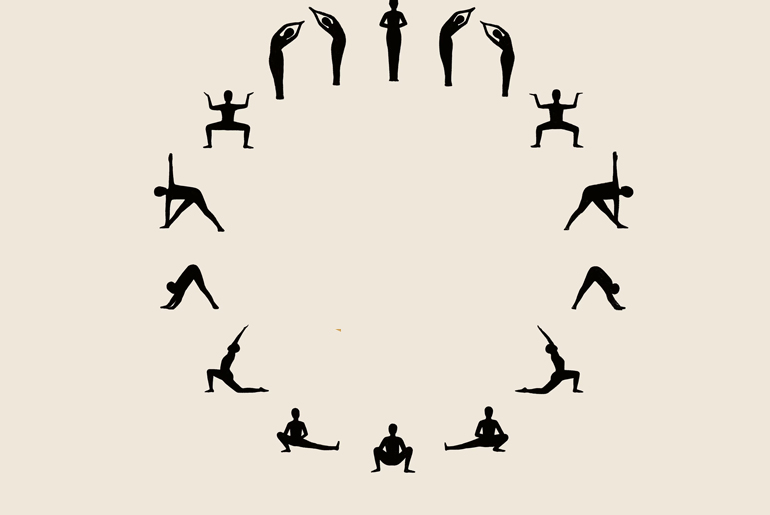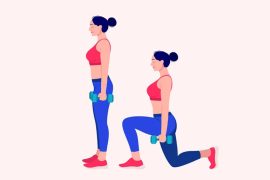Chandra Namaskar, or Moon Salutation, is a gentle sequence of yoga poses designed to balance and calm the body’s energy. Unlike the dynamic and invigorating Sun Salutation (Surya Namaskar), Chandra Namaskar is typically slower and more soothing, making it ideal for evening practice or during the moon phase. This sequence emphasizes tranquility and relaxation, helping to harmonize the mind and body while promoting a sense of peace.
Step-by-Step Guide
1. Preparation (Tadasana)
- Starting Position: Stand tall with your feet together, arms by your sides, and weight evenly distributed on both feet.
- Posture: Engage your thighs, lift your chest, and lengthen your spine. Bring your palms together in a prayer position at your chest.
2. Inhale and Raise Arms (Urdhva Hastasana)
- Action: Inhale deeply and slowly raise your arms overhead, keeping your palms facing each other or touching.
- Alignment: Stretch your arms and fingers upward, engaging your core.
3. Side Stretch (Ardha Chandrasana)
- Action: Exhale and gently lean to the right, keeping your left arm extended and your right arm reaching down along your leg or to the floor.
- Benefits: This stretch helps in opening the side body and improving flexibility.
4. Forward Bend (Uttanasana)
- Action: Exhale and fold forward at the hips, bringing your hands to the floor or to your shins. Keep your knees slightly bent if necessary.
- Benefits: This pose calms the mind and stretches the hamstrings and lower back.
5. Plank Pose (Phalakasana)
- Action: Step or jump back into a plank position, aligning your body in a straight line from head to heels.
- Benefits: Builds core strength and stability.
6. Lower to Chaturanga (Chaturanga Dandasana)
Action: Lower yourself into a low push-up position, keeping elbows close to your body. Your shoulders should be in line with your elbows.
Benefits: Strengthens the upper body and core.
7. Cobra Pose (Bhujangasana)
- Action: Inhale and lift your chest off the ground into a gentle backbend, keeping your elbows slightly bent and your shoulders away from your ears.
- Benefits: Opens the chest and stretches the abdominal muscles.
8. Downward-Facing Dog (Adho Mukha Svanasana)
- Action: Exhale and lift your hips up and back, forming an inverted V shape with your body. Press your heels toward the floor and spread your fingers wide.
- Benefits: Stretches the entire body and helps in relieving stress.
9. Forward Bend (Uttanasana)
- Action: Step or jump forward to return to the forward bend position. Breathe and relax into the pose.
10. Side Stretch (Ardha Chandrasana)
- Action: Repeat the side stretch on the left side, mirroring the earlier movement on the right.
11. Inhale and Raise Arms (Urdhva Hastasana)
- Action: Inhale and return to the standing position, raising your arms overhead.
12. Return to Starting Position (Tadasana)
- Action: Exhale and bring your arms down to your sides, returning to the starting position.
Benefits of Chandra Namaskar
Chandra Namaskar, or Moon Salutation, offers a variety of benefits due to its gentle and calming sequence of poses. Here’s a detailed look at its benefits:
1. Balances Energy
- Calming Effect: Chandra Namaskar is designed to harmonize the body’s energies, particularly the cooling and soothing aspects. This makes it ideal for reducing stress and promoting mental calmness, especially in the evening.
2. Improves Flexibility
- Enhanced Range of Motion: The sequence includes stretches and bends that increase flexibility in the spine, hips, and legs. Regular practice helps in improving overall body flexibility.
3. Supports Digestive Health
- Stimulates Digestion: The forward bends and gentle twists in Chandra Namaskar massage and stimulate the digestive organs, which can improve digestion and relieve bloating.
4. Promotes Relaxation and Stress Relief
- Stress Reduction: The slow, deliberate movements and deep breathing involved in Chandra Namaskar help calm the nervous system, reducing stress and anxiety.
Preparation for Sleep: Practicing Chandra Namaskar in the evening can help relax the body and mind, making it easier to fall asleep and enjoy restful sleep.
5. Enhances Mental Clarity
- Mental Focus: The meditative aspect of the sequence helps clear the mind, improve concentration, and promote mental clarity.
6. Builds Strength
- Core and Upper Body Strength: Poses like plank and chaturanga build strength in the core, arms, and legs, contributing to overall muscle toning and endurance.
7. Improves Posture
- Spinal Alignment: The sequence encourages proper spinal alignment and strengthens the muscles supporting the spine, leading to improved posture.
8. Boosts Immunity
- Immune System Support: By reducing stress and improving overall well-being, Chandra Namaskar supports a healthy immune system, helping the body fend off illnesses.
9. Enhances Circulation
- Improves Blood Flow: The gentle movements and stretches promote better blood circulation, which supports cardiovascular health and reduces the risk of blood clots.
10. Promotes Emotional Well-being
- Emotional Balance: The practice helps in balancing emotions and fostering a sense of inner peace, which can be particularly beneficial for emotional health and stability.
11. Encourages Mindfulness
- Mind-Body Connection: The focus on breath and movement in Chandra Namaskar enhances mindfulness, helping you stay present and connected to your body.
12. Alleviates Fatigue
- Energy Boost: The sequence helps relieve tiredness and invigorate the body, making you feel more energized and refreshed.
Considerations:
Chandra Namaskar (Moon Salutation) is generally a gentle and beneficial practice, but there are specific groups of people who should avoid or approach it with caution. Here are some who might need to avoid or modify Chandra Namaskar:
1. Individuals with Severe Back Pain or Injuries: Those with acute or severe back pain, herniated discs, or spinal injuries might find certain poses in Chandra Namaskar exacerbating their condition. It’s essential to consult a healthcare provider before attempting the practice.
2. People with Knee Problems: Individuals with knee injuries or chronic knee pain should avoid poses that put strain on the knees or perform modifications to reduce discomfort.
3. Pregnant Women: While some pregnant women may practice modified yoga sequences, Chandra Namaskar’s poses might not be suitable, especially in the later stages of pregnancy. It’s best to consult with a healthcare provider and consider prenatal yoga classes.
4. Those with Recent Surgeries or Injuries: Individuals recovering from recent surgeries or injuries should avoid or modify the practice based on their doctor’s advice. The body needs time to heal before resuming yoga.
5. People with Heart Conditions: Although Chandra Namaskar is generally gentle, those with serious heart conditions should consult with their healthcare provider to ensure the practice does not strain their cardiovascular system.
6. Individuals with High Blood Pressure: While Chandra Namaskar can help in lowering blood pressure, those with severe hypertension should consult their doctor before engaging in any new physical activity, including yoga.
7. People with Balance Issues: The practice involves various balancing poses, which may be challenging for individuals with balance issues or dizziness. Modifications or alternative practices might be more suitable.
8. Those with Severe Asthma or Respiratory Issues: People with severe asthma or other significant respiratory conditions should approach the practice cautiously and ensure they have proper medical advice on how to handle physical exertion.
9. Individuals with Osteoporosis: Those with osteoporosis should avoid poses that put excessive pressure on the bones or involve deep stretching. Modified versions of poses may be more appropriate.
10. People with Severe Anxiety or Panic Disordersh: Although Chandra Namaskar is calming for many, those with severe anxiety or panic disorders should consult with a mental health professional to determine if the practice is beneficial or if other approaches might be more effective.
11. Beginners Without Guidance: Beginners who have not been properly instructed in the practice might risk improper technique and potential injury. It’s beneficial to learn Chandra Namaskar under the guidance of a qualified yoga instructor.
For those in these categories, modifications to Chandra Namaskar or alternative practices that better suit their needs might be more appropriate. Always consult with a healthcare provider or a qualified yoga instructor to ensure that the practice is safe and tailored to individual health conditions and needs.
Disclaimer:
The information contained in this article is for educational and informational purposes only and is not intended as a health advice. We would ask you to consult a qualified professional or medical expert to gain additional knowledge before you choose to consume any product or perform any exercise.








